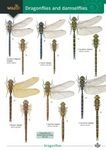Field / Identification Guide World / Checklist
By: Adrian M Riley(Author), Pam Taylor(Foreword By)
256 pages, colour photos
Foregoing taxonomic grouping, this photographic field guide organises British dragonfly and damselfly species by their appearance, making this an especially useful book for field naturalists.
![Dragons & Damsels Dragons & Damsels]()
Click to have a closer look
About this book
Contents
Customer reviews
Biography
Related titles
About this book
The order Odonata is an ancient insect group going back some 250-325 million years. Whilst over 6,000 species are known globally, with 36 dragon- and 21 damselflies in the British Isles, their identification can be difficult, especially for newcomers wishing to observe and study these fascinating predatory insects. Dragons and Damsels is a comprehensive and user-friendly photographic identification guide designed to help find and identify all species, sexes and forms. To simplify identification, they have been split into groups of superficially similar taxa with clear descriptions and with over 300 photographs, including comparative close-ups of characteristic morphological features. Essential field notes and habitat photographs will aid finding each species.
Contents
Foreword Dr Pam Taylor
Acknowledgements
Introduction
How to use this book
Systematic checklist and status of all species recorded in the British Isles
Anatomy
Chapter One: Species accounts of the resident Damselflies
Chapter Two: Identification of the resident Damselflies
Chapter Three: Species accounts of the resident Dragonflies
Chapter Four: Identification of the resident Dragonflies
Chapter Five: Potential colonists
Chapter Six: Review of scarce vagrants and extinct residents
Appendix I: Map of Vice-counties
References and further reading
Index
Customer Reviews
Biography
Adrian Riley, a professional entomologist with over 40 years of experience, is author of several books about wildlife, including field guides such as British and Irish Butterflies and Norfolk Wildlife, and his autobiographical account Arrivals and Rivals. He now lives in Norfolk from where he leads
wildlife tours, both within the UK and abroad.
Field / Identification Guide World / Checklist
By: Adrian M Riley(Author), Pam Taylor(Foreword By)
256 pages, colour photos
Foregoing taxonomic grouping, this photographic field guide organises British dragonfly and damselfly species by their appearance, making this an especially useful book for field naturalists.
"In the main, most field guides follow the same pattern, with species accounts laid out in taxonomic sequence. The new guide by Adrian Riley does indeed have two chapters of species accounts covering damselflies and then dragonflies separately. Where this new guide differs, however, is in its approach to the identification of individual insects.
Again, damselflies and dragonflies have their own chapters, but within these, species are grouped according to their appearance, with males and females often treated separately due to their differing colours and patterns. This makes sense when you understand that early dragonfly observers actually thought that, for example, male and female Banded Demoiselles were of two different species because they looked so dissimilar.
Adrian Riley’s meticulous approach to each species, sex and colour-form throughout the book should leave no-one in doubt of an identification. There is no question at all that this new guide, with its fresh approach, detailed descriptions and clear photographs, will find a place on the bookshelf of many dragonfly watchers and recorders, no matter how experienced."
– Dr Pam Taylor, British Dragonfly Society







































